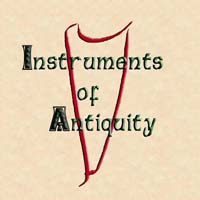
create for you?
(Links lead to detailed pages with larger photos and more information...)
Authentic:
Citole:
Cantigas style
Warwick style
Drums:
Bodhran
Gusli
Harps:
Bardic/Lap Harps:
Gut Strung
Celtic Wire Strung
Floor Harps:
Gothic
(more to come)
Kantele:
5 string
5 string Piccolo
9 string
Performance set
Lyres:
Trossingen
Sutton Hoo
Mosning Thorpe
Bergh Apton
Oberflacht
Cologne
Student Model
Bowed Lyres:
Crwth
Jouhikko
Psaltries:
Pig Nose
Cantigas style
Rebecs:
Soprano
Alto
Tenor
Bass
Zithers:
Fretted:
Epignette
Scheitholt
Fretless:
Myrna Hammered Dulcimer
Echoic:
Non-authentic,
but imitative of
the sound of the original instrument
Flutes
Whistles
Scheitholt

The plucked fretted zither has existed in many cultures and time periods, and still has a growing and living following in dozens of countries. The simple 3 stringed plucked fretted zither was based on Praetorius drawings from the early 16th century of an instrument from Germany. This was likely the direct ancestor of the Appalacian Mountain Dulcimer, as that region was settled by more immigrants from Germany than from the other countries in which the zither was popular.
This instrument, known regionally as Zitter, Zither, Scheitholt, Langeleik, Langspil, Hummel and Epinette des Vosges among others, differed by fret patterns, number of strings, and general body shapes. Instruments were built for one player, or for two players who faced each other and had their own sets of strings to play on a single body.
There were variants that could be played with a bow, but most were plucked. A few of the strings ran above a fretboard, and the rest were drones. Most of the instruments strings were stopped with a noter, a rod or bar that was used to fret the strings instead of fingers. This is similar to the glass or metal slide used by steel guitar players.
Most well-regarded historical treatises regard this as a 'low' instrument, a folk instrument of base origin and use. But the regional histories and living traditions speak volumes to the contrary. This was an instrument for accompanying living history recitations, for dancing and celebrating, for ballad song and to promote the enjoyment of time spent with friends and family. Each new zither brings to the world another haunting voice, an enduring melody. Let us see how we can build one that truly reflects your individual spirit.
For
more information or to place an order, contact:
Chris Nogy,
founder and craftsmancontact@instrumentsofantiquity.com
Phone: 479-283-6364
Please call between 9 AM and 7 PM U.S. Central Time (-6 GMT)
copyright (c) 2011